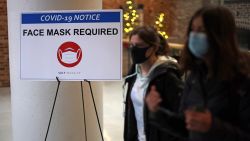Editor’s Note: Pamela Loprest is a senior fellow and labor economist in the Income and Benefits Policy Center at the Urban Institute. The opinions expressed in this commentary are her own.

The $1.9 trillion American Rescue Act of 2021 contains much-needed relief for millions of struggling unemployed workers, as well as those earning low wages — with people of color and women disproportionately represented in both groups. But to make our economy more equitable and address the needs of out-of-work and underemployed Americans, we need longer-term solutions.
The latest Covid relief package provides increased unemployment insurance payments, stimulus checks, emergency rental assistance, additional nutrition benefits, health insurance premium assistance, child tax credits and other supports. All of these programs are helpful, but they only offer short-term relief.
To truly help workers in low-paying, lower-quality jobs, the government also needs to implement longer-term policies and investments in education and training for workers in growing high-wage sectors, such as health care and technology. Coupled with supports, such as tuition subsidies, access to childcare for parents and programs designed to make balancing work and school easier, the government can increase equitable access to job training.
The government can also help boost job quality. One of the first steps is increasing the minimum wage, though a provision to do so was removed from the stimulus plan in a missed opportunity. A recent study from the Congressional Budget Office estimates that an increase in the minimum wage to $15 an hour would result in modest job losses while increasing wages for 27 million workers and lifting 1.3 million people out of poverty.
But low pay is just one issue for these workers. Low-wage jobs are less likely to provide employer benefits, such as health insurance, retirement plans and paid leave. These jobs also tend to come with greater safety and health risks than higher-paid jobs.
Government can help by improving and expanding access to benefits like affordable health insurance, retirement saving vehicles and paid sick and family leave. The federal government realized the importance of these benefits for workers by extending paid leave for workers early on in the pandemic, and more recently by making health insurance more accessible and affordable. But it made these fixes temporary and failed to address the ongoing need.
Making permanent changes in job quality can have significant impacts for workers, including greater physical and mental health, increased savings and reductions in stress and occupational injuries.
Of course, job quality consists of more than wages and benefits. Government solutions to improving job quality also include implementing responsible health and safety regulations, anti-discrimination and harassment protections, hours and scheduling standards and worker protections.
In addition, a federal jobs program that subsidizes private-sector employers to hire unemployed, formerly low-wage workers could benefit employers that are struggling during the recession and help workers earn an income and establish a long-term job. During the Great Depression, the Works Progress Administration provided unemployed workers with jobs in public works, the arts and community development, with some of their output in bridges, parks and dams still visible today.
A new federal program could provide temporary subsidies to employers that would guarantee to keep the workers on the job for a time after the subsidy expires. In fact, during the height of the Great Recession in 2009, public jobs programs subsidized hundreds of thousands of unemployed workers in private companies, as well as public and community-based organizations. Evaluation of these programs found participants in most programs experienced significant increases in unsubsidized employment in the year after the program. Providing subsidies to private-sector businesses that create jobs that pay a living wage, and that will eventually transition to unsubsidized work, could help both employers and workers.
President Biden has promised to invest in infrastructure, such as roads, bridges, water supply and clean technology, and to create jobs. Hopefully, policymakers will invest in workers as part of this initiative, and include measures that will boost equitable access to quality jobs for all workers.

























